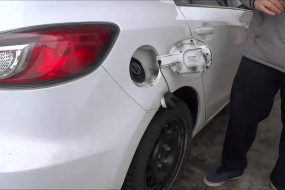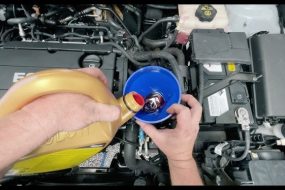
The vehicle’s transmission system is a complex network of components working in harmony to ensure easy power transfer from the engine to the wheels.
The constant velocity joint popularly known as the (CV joint) is responsible for transmitting power from the transmission to the wheels while accommodating the up-and-down motion of the suspension. But what happens when the CV joint goes bad? Can a bad CV joint affect the transmission?
Yes, a bad CV joint can affect the transmission system of a vehicle by causing an uneven power distribution affecting the overall performance of the vehicle, increasing stress on transmission components, and transferring vibrations to the transmission.
Can a Bad CV Joint Affect the Transmission?
Yes, a bad CV joint can affect the transmission system of a car because the CV joint is a component in the drivetrain that connects the transmission to the wheels and allows for the transmission of power to the wheels while accommodating the up-and-down motion of the suspension. Therefore, when it goes bad, it can have several adverse effects on the transmission.
The CV joints are positioned at both ends of the drive axles to provide flexibility and allow the axles to bend and change length as the vehicle navigates uneven terrain.
This adaptability is important for maintaining a constant velocity, preventing power loss and vibrations during turns and suspension movements. Therefore, when it goes bad, it can affect the transmission through:
- Power transmission disruption
- Increased stress on transmission components
- Vibration transfer to the transmission
- Fluid contamination
How Can a Bad CV Joint Affect the Transmission?
Here’s a detailed breakdown of how a bad CV joint can affect the transmission:
1. It will Disrupt Power Transmission to the Wheels
A CV joint in good condition ensures the smooth transfer of power from the transmission to the wheels, allowing for a constant velocity during turns and suspension movements.
When a CV joint is damaged or worn, it may not transmit power efficiently. This can result in uneven power distribution to the wheels, affecting the vehicle’s acceleration, performance, and overall drivability.
The disruption in power transmission can lead to a decrease in the vehicle’s efficiency and may also contribute to increased fuel consumption.
2. It Will Increased Stress on Transmission Components
A failing CV joint puts additional stress on the remaining components of the drivetrain, including the transmission.
The transmission is designed to handle a specific load, and when a CV joint is compromised, the transmission may need to work harder to compensate for the loss in efficiency.
The increased stress on transmission components, such as gears, bearings, and seals, can accelerate wear and tear, leading to more issues and costly repairs.
3. It Can Lead to Vibration Transfer to the Transmission
A common symptom of a bad CV joint is vibrations, particularly during acceleration and turns. Vibrations generated by a bad CV joint can transfer to the transmission causing the the transmission mounts to wear out prematurely, especially when the vibration is excessive and is not treated on time.
Since the transmission mounts are important for dampening vibrations and securing the transmission in place, if they fail due to increased vibrations, it can lead to further complications in the transmission system.
3. It Can Lead to Fluid Contamination
The CV joint is protected by a rubber boot that contains grease to lubricate the joint’s moving parts. When a CV joint boot is damaged or torn, it can lead to the leakage of grease.
This not only accelerates wear on the CV joint but can also introduce contaminants, such as dirt and debris, into the joint.
If these contaminants find their way into the transmission fluid, they can compromise the fluid’s quality and contribute to increased friction and potential damage within the transmission.
Therefore, it’s important for vehicle owners to be aware of the signs of a bad CV joint, which may include clicking or popping noises during turns, vibrations during acceleration, grease leaks, and visible damage to the joint or axle.
Knowing these problems on time and fixing them on time can help prevent these problems from affecting the transmission.
Moreover, as a driver, you should adopt some preventive measures such as replacing damaged CV joint boots as soon as possible, avoiding extreme driving conditions that can accelerate wear, and addressing any symptoms of CV joint failure as soon as they are noticed to prohibit it from affecting the transmission.
How to Prevent Bad CV Joint from Affecting Your Transmission
Here’s how you can stop a bad CV joint from affecting your transmission:
- Perform Regular Inspection: Periodically inspect the CV joints for signs of wear, tear, or damage. Catching issues early can prevent them from escalating and affecting other components, including the transmission.
- Replace the CV Joint Boot When Due: Replace damaged or torn CV joint boots as soon as possible to prevent grease leakage and contamination. This simple preventive measure can extend the lifespan of the CV joint and protect the transmission.
- Avoid Extreme Driving Conditions: Limit exposure to harsh driving conditions, such as off-road terrain or pothole-ridden roads. Such conditions can accelerate wear on CV joints and increase the likelihood of premature failure.
- Repair Damaged Parts on Time: If you notice any symptoms of a failing CV joint, fix them as soon as possible. Ignoring the warning signs can lead to more extensive damage, affecting the transmission and resulting in costlier repairs.
Conclusion
A bad CV joint can have a cascading effect on the transmission system, disrupting power transmission, increasing stress on transmission components, transferring vibrations, and leading to fluid contamination.
However, getting hold of the problem on time and repairing/replacing whatever is wrong with the CV joint can help prevent these issues from impacting the overall performance and longevity of the transmission.









